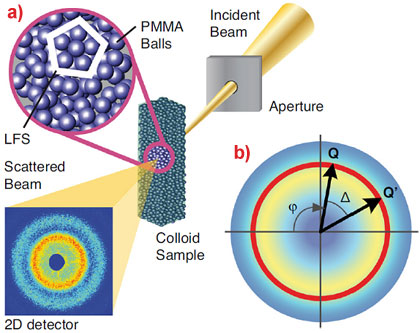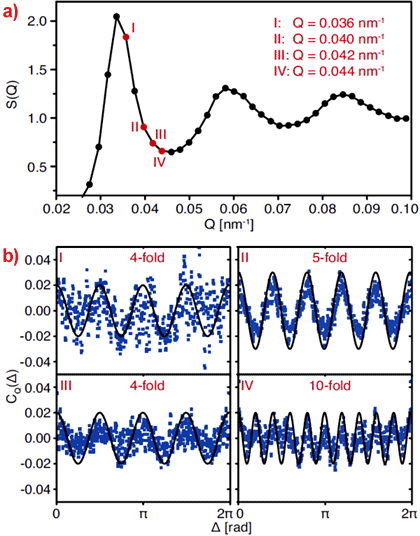- Home
- News
- Spotlight on Science
- Local symmetries...
Local symmetries in disordered matter uncovered by coherent X-ray scattering
25-09-2009
Local symmetries in colloidal glasses were investigated by coherent X-ray scattering. The speckle patterns were analysed by a novel angular cross correlation technique to unravel the hidden local symmetries within the glassy disorder. Four-, 6-, 10- and most prevalently 5-fold symmetries were observed pointing towards locally-favoured structures of icosahedral symmetry.
Share
The existence of clusters with local symmetries in otherwise disordered materials is a topic of long standing interest in condensed matter physics, in particular in connection with the glass transition. Dynamical heterogeneity and the relation to local rearrangements is a subject of intense research but direct experimental evidence is rare. In this study, highly concentrated glassy suspensions of sterically stabilised PMMA particles were investigated by coherent X-ray scattering at beamline ID10A. When coherent light is scattered from disordered matter, a speckle pattern is generated in the far field due to the interference of radiation coming from the entire scattering volume and the (not completely) random phase shifts by the particles. An example of a speckle pattern is shown in Figure 1 together with a sketch of the experiment.
To extract information on the local ordering hidden in the speckle pattern, the scattered intensity was analysed for angular correlations by calculating

where Δ is the azimuthal angle difference between two points in the speckle pattern (see Figure 1). The averaging indicated by the brackets is taken over the entire ring φ∈[0;2π] with |Q|=Q. The average static structure factor S(Q) that is frequently measured by “incoherent” X-ray scattering depends only on pair-correlations. For amorphous samples it does not depend on bond angles. In contrast a speckle pattern represents a unique fingerprint of the sample without the usual ensemble average. This allows a test for angular bond orientational order via the 4-point correlator CQ. Most fascinating is that CQ(Δ) clearly reveals a very pronounced anisotropy with 5-fold symmetry specifically for the intensity ring associated with Q=0.04 nm-1, which points to a local symmetry in the colloidal system that was thus far hidden. The different Q-dependent symmetries are a signature of the specific local order. The colloidal glasses investigated here are slowly evolving; hence the analysis could be performed over time intervals much shorter than the typical speckle decay time (~200 s) to yield the temporal evolution of the local ordering. The emerging picture is that clusters of icosahedral order reorganise themselves and are formed either in nano-crystalline environments or out of complete disorder, all of which involves the breaking and formation of bonds. This bears similarities to the behaviour observed in simulations of supercooled molecular liquid glass-formers and underlines the importance of local rearrangements in the understanding of the dynamical properties of this important class of non-periodic materials. The availability of short-pulse XFEL radiation in the 0.1-nm regime and with 100-fs pulse length will open up the fascinating option to analyse the local structure of liquids (in particular also water) by applying the new concept of X-ray cross correlation analysis (XCCA) to single laser shot speckle diffraction patterns.
Principal publication and authors
X-ray cross correlation analysis uncovers hidden symmetries in disordered matter, P. Wochner (a), C. Gutt (b), T. Autenrieth (b), T. Demmer (a), V. Bugaev (a), A.D. Ortiz (a), A. Duri (b), F. Zontone (c), G. Grübel (b), and H. Dosch (a,b), PNAS 106, 11511-11514 (2009).
(a) Max-Planck-Institut für Metallforschung, Stuttgart (Germany)
(b) DESY, Hamburg (Germany)
(c) ESRF
Top image: Icosahedral symmetry in glasses.





